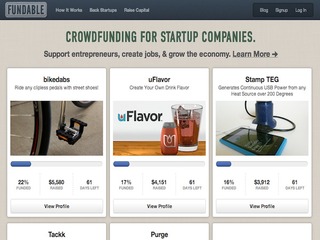MyFitnessPal launches support tools for patients on GLP-1 meds
The tools include content such as educational videos, recipes, and daily nutrition tips
Read more...
Crowdfunding can be a pretty wonderful thing. It is a tool that can be used in many, many different ways. By artists getting support from their fans, by political campaigns using grassroots organizing, by disaster relief organizations or, as with the JOBS Act that was passed by Congress, used to fund start-ups and small business.
And, it can be used for philanthropic causes. That’s where companies such as Rally.org come in.
Designed to allow average users collect money for advocacy groups, alumni groups, churches, even to help students raise money for college, Rally is less interested in starting the next big thing than to assist its users in making the users into "better organizers and communicators" so that they can get their messages out more effectively.
In an interview with VatorNews, Tom Serres, CEO and co- founder of Rally, described the site as a way to help the average Joe “become a more successful and more effective storyteller.”
The storytelling element is fundamental to what is behind Rally, and is what makes them different from other competing crowdfunding sites.
Telling a story, Serres says, is a key aspect to getting people to donate to a cause. And Rally lends a hand to the average user by helping them post photos and videos.
User can sync their causes to social networks, as well as their own websites, setting up a peer network that will get people to join their cause and to get their message out to a broader audience.
Giving people this framework is what sets the site apart from others like Kickstarter and Causes, says Serres. Those sites do not allow their users to be the most effective storytellers they can be, and Rally is constantly analyzing data from the site to improve users’ storytelling skill to maximize their fundraising capabilities.
“We are constantly improving, through large-scale data analysis, the ability to tell stories and in turn monetize those stories.”
How much do causes raise?
While one cause on the site has raised $10 million (Serres would not disclose which one), the amount of money raised can vary wildly.
“They can raise as little as a few hundred dollars or they can raise as much as tens of millions of dollars,” Serres says.
Instead of short-term fundraising goals, the site helps to establish an ongoing relationship with the donors who can continue through other projects. Serres says that, for this reason, he considers all of the causes to have been successful, whether it was one that raised only a few hundred dollars, or it was the student who raised $70,000 to go Cornell.
History of Rally
Rally has been around since 2009, when it was first known as Piryx. Originally it was based in Austin, Texas and was a “political paypal,” which would raise money online for political causes. Its most notable client was Representative Joe Wilson, famous for shouting “You lie!” at the President during his State of the Union address in 2009.
There was intense demand from users to do work outside of the political realm, and so the site was opened up to the public, so anyone with a cause could join.
“You do not have to be a 501c3 organization or a political candidate to raise money, you simply have to tell a story,” says Serres.
The site eventually moved toward non-profit groups in 2011. It received an undisclosed amount of seed money from Reid Hoffman and Mike Maples. Headquarters were moved to San Francisco in June 2011 and Rally went live in November 2011.
Since then Rally has seen impressive growth. The start-up now has 1.5 million users, 13,000 of which are the owners of causes on the website.
“For nearly a decade we have been at the intersection of fundraising and technology and we know what works and what doesn’t work when raising money. Now we are building the technology platform to support our years of experience and have merged it with the insights we have learned from big data,” Serres says.
The site makes money through a built payment network where money is taken out of the transactions. The 4.5% taken out of every donation includes credit card fees and a fraud management fee. The reason that the site does not charge a monthly fee for those putting up the causes is that Serres wanted to make the website accessible to everyone.
While Serres says the site does not police its causes, so it does not protect against potentially fraudulent activity, the website does protect against illegal activities such as money laundering.
The tools include content such as educational videos, recipes, and daily nutrition tips
Read more...Advances in technology, like in vitro and microfluidics, have helped advance research
Read more...Robots are taking over the heavy lifting work inside warehouses
Read more...




